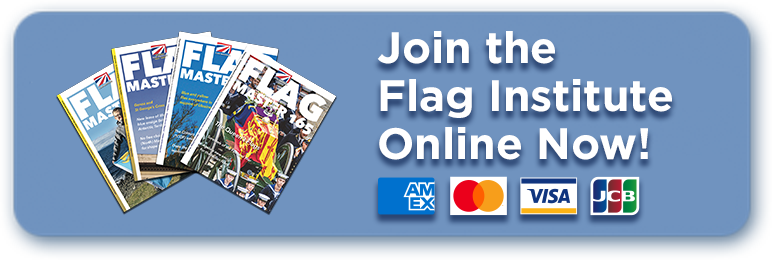Each year we hold a Spring and a Winter Conference, and in 2021/22 we ran a special Golden Jubilee gala programme.
AGM and Winter ’25 Conference
Saturday 15 November 2025, 10.00 to 15.30 GMT
FREE and ONLINE for FI members and friends worldwide.
- BOOK NOW: https://www.eventbrite.co.uk/e/flag-institute-agm-and-winter-2025-conference-tickets-1460810055199
The AGM will offer the chance for members to put their questions to the FI Council and vote on appointments.
Presentations announced…
- 40th Anniversary of the Dublin Municipal Flag – Stan Moore MA FGSI, Non-Executive Director of Genealogical Society of Ireland
On 22 June 1885 the Dublin Municipal flag was first flown over City Hall. The Irish Times described it as green, featuring a central yellow harp and three white castles on a blue field in one corner. The design combined elements of three earlier flags: the Green Harp flag, the Green Ensign, and the armorial banner of Dublin’s coat of arms. Until then, the armorial banner had served as the city’s flag. Its removal followed an incident on the night of 23 to 24 March, when it was stolen from the Mansion House, most likely by loyalist students from Trinity College. The theft was seen as a response to nationalist Lord Mayor John O’Conner, who declared in a speech that he would take down the flag if the Prince of Wales arrived in Dublin.
The new flag represented a shift in civic identity. It is still in use today as the official flag of Dublin City Council and flies proudly throughout the city.
- Rotterdam and Papendrecht: Flag histories and protocols – Edgar Zaagsma, Papendrecht municipal official and Consul for the War Graves Foundation
This two-part presentation will focus first on the city of Rotterdam and then on the municipality of Papendrecht. In part one, Edgar will explore the history of the Rotterdam flag, the development of the city’s municipal coat of arms, and the presence (or absence) of Rotterdam’s colours in everyday life. In part two, he’ll turn to Papendrecht, offering a brief overview of its flag and coat of arms, with particular stress on the official flag protocol written for the municipality. Edgar will highlight how and why this local protocol differs from the national approach.
- Raising respect: How the International Center’s Flag Program builds cultural understanding – Peter Kirkwood, Protocol Officer, The International Center
The Flag Program of the International Center’s Office of Protocol promotes cultural awareness, civic pride and international understanding through the proper display and care of national, state and organisational flags. Featuring a complete United Nations flag collection and a growing number of flags and banners, the Program serves as a resource for schools, community groups, state and local governments and visiting delegations. Peter will explore the Program’s history, outreach and alignment with global protocol standards. Showcasing flags as powerful symbols of respect and identity, he will highlight their enduring role in connecting nations and the communities of Central Indiana.
- State Emblems in Greece, 5th–3rd Centuries BC – Jorge Hurtado Maqueda, President, Sociedad Española de Vexilología (SEV); presented by José Manuel Erbez, Secretary, SEV
Jorge’s presentation explores the use of emblematic symbols in Classical and Hellenistic Greece, examining how states expressed authority and identity through visual means during a formative period in ancient history. Structured in three parts, the study will review the surviving sources and the interpretive challenges they present, consider how state emblems were deployed in land warfare and naval conflict, and conclude with a comparative reflection on the symbolism of the Greek and Roman worlds. Rich in historical insight and analytical depth, this contribution from the SEV offers a fascinating perspective on early state symbolism and the origins of vexillological practice.
- Armenian revolutionary flags: Photography and propaganda – Maxim Saakyan, founder of Uncovering Roots; Leo Torosian, law student and political staffer
Producer Maxim Saakyan worked on this story with Leo Torosian for Uncovering Roots, a podcast that covers untold stories and has been featured in the Guardian and on Spotify. When Leo started researching Armenian revolutionary flags, he found hundreds of photographs. Fighters posing with rifles, daggers and, almost always, flags. Not the kind you’d see flying at the Olympics, but flags covered in swords, slogans, skulls, crosses and dates, stitched by hand. These weren’t just battle flags, they were propaganda. Today, only a dozen or so of these flags have physically survived. The rest exist only in staged photographs, carefully posed and sent across borders to fundraise, recruit and inspire. Together, Max and Leo will demonstrate how flags became more than symbols; they became evidence of a movement fighting for survival, statehood and honour.
- Pride Flags of today: Origin, metamorphosis and current designs – Heather Binnington, retired teacher from the York Region District School Board (Canada)
Where did Pride Flags begin? Where have they been, and what do they look like today? Heather will show how these continually evolving flags attentively adapt to the communities they serve and provide answers to the questions regularly asked about the Standard and Progress Pride Flags.

